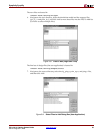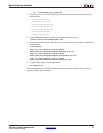
PCI v3.0.151 Getting Started Guide www.xilinx.com 53
UG157 August 31, 2005
R
Chapter 6
Implementing a Design
This chapter describes how to implement the ping64 example design with global clocks
using the supported FPGA implementation tools (included with the ISE Foundation v7.1
Development System). For the PCI 32 interface, substitute ping32 for ping64. If you are
using a design with reference clocks, substitute pcim_top with pcim_top_r and ping_tb with
ping_tb_r.
ISE Foundation
Before implementing a design, ensure that the Xilinx environment is properly configured
and the design has been successfully synthesized.
1. Navigate to the implementation directory:
cd <Install Path>/hdl/example/xilinx
This directory contains the run_xilinx script that calls the appropriate tools to place and
route the example design. Scripts are provided for Unix and Microsoft Windows operating
systems.
2. Review the appropriate run_xilinx script file, noting the following:
• Several required special environment variables are set at the beginning of the
script; do not remove them.
•The ngdbuild command lists both ../../src/xpci and ../synthesis as
search directories. The xpci directory contains a netlist of the PCI interface, and
the synthesis directory must contain the EDIF netlist generated during design
synthesis.
The ngdbuild command also reads a user constraints file that corresponds to a
desired target device and a particular version of the PCI interface.
• To target a different device or to use a different version of the PCI interface, the
constraints file must be changed to match the device and interface selection. The
available selections are defined in Chapter 3, “Family Specific Considerations.”
The user constraints files provided with the PCI interface include constraints that
guarantee pinout and timing specifications. These constraints must always be
used during processing.
Additional constraints that relate to the user application must be placed in this file.
Before making additions to the user constraints file, back up the original so that it
can be restored if necessary.
•The map command requires no special arguments, but uses an input/output
register packing option.


















